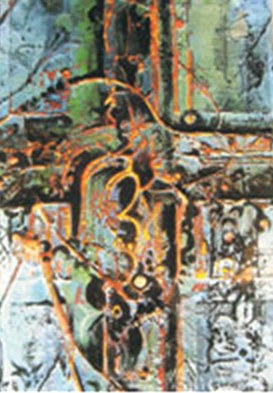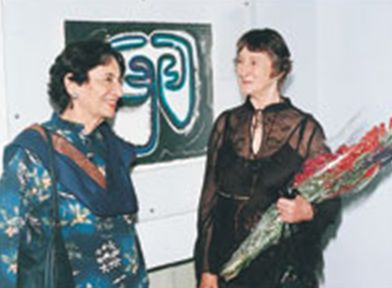Mary Katrina Taylor
This is a collection of articles archived for the excellence of their content. Readers will be able to edit existing articles and post new articles directly |
Mary Katrina Taylor
Multi-layered Mary
By Miriam Habib
On a balmy spring evening earlier this year the National College of Arts sponsored a unique painting exhibition featuring selected works of a husband and wife artist duo. It was a stimulating event for art lovers in the cultural hub that is Lahore.
Anwar Jalal Shemza met and married Mary Katrina Taylor in the U.K. where he had gone in the late fifties to gain a diploma from the Slade School of Art. She was completing her Art teacher’s certificate at London University College. Together they discovered a common love of calligraphic art and their life together was in part an ongoing experiment and exploration in the realm of this most expressive and mysterious of vocations. Anwar Jalal was reared in the wonderful shapes of Arabic and Persian scripts. Mary’s background yielded a love for Roman letters. Since all writing originated from ideograms and pictograms the pictorial content complements their graphic work. After a short residence in Pakistan the couple moved to Mary’s hometown in the English Midlands where both pursued careers as secondary school art teachers, heading their respective departments.
After Shemza’s sudden death in 1985 Mary brought an exhibition of his most recent work, the ‘roots’ series which the Pakistan Council took to all the major cities.
The 2005 exhibition, twenty years later displayed a cross section of works by both artists in two separate galleries. Anwar Jalal’s place in Pakistan and world art is deservedly renowned. But here, I will highlight the contributions of Mary Shemza, a creative genius in her own right.
As already mentioned, both artists found inspiration from their separate calligraphic heritages.
Mary was steeped in the classical beauty of the Roman script, she uses it straight forwardly, ornamented and otherwise, to record a message. Elsewhere she weaves a mood or design in harmony with the text, as in “If a child” ..... in which the sentence moves in circular lines as a small child might play innocently in a garden.
The thorough grounding in calligraphy does not preclude her interest in the discipline of figurative painting and total abstraction. The mediums may be traditional oil and water colour or she may venture into collage composition incorporating plasters, leaves, feathers and paint to produce multi-layered metaphysical effects. It seems like an attempt to capture the transitory to manifest it as themes for higher contemplation.
Mary Shemza is comfortable with many approaches and many mediums simultaneously. Yet overall there is evidence of a trained, controlled hand and eye. The ‘action’ is of thought and intellect, distilled observation and experience presented in the language of art.
Both practical and an artist without bounds, she works to commission for calligraphy and realistic paintings. On her own she is Mary, the ‘meem’ of Shemza’s dreams, free to see, feel and express. As Mary points out the letter ‘meem’ features in many of her husband’s abstract compositions, as a reference to the first letter of the Holy Prophet’s name (PBUH). It also happens to be the first letter of her own name.
Mathematics was Mary’s best subject in school, but she liked her art teacher, apparently her reason for choosing it for a lifetime’s expression. Every year in school she won prizes in painting and calligraphy, going on to achieve her National Diploma in Design.
Teaching has been so dominant an element of her creative existence, she has taught her students to be aware of background and spaces. In her life she has made work, family life, artistic achievement and promotion of aesthetic values into a beautiful tapestry of its own.
“Painting is magic” she says, “You take a brush, paint and create, either the visual or the imaginative. She likes experimenting and her work tends to be flat. She also likes stripes, due perhaps to blinds in her childhood room. Figurative work is very much a part of her repertoire because she teaches.
But Mary is most challenged by nonfigurative expression, she says it is the distillation of feelings and visual vocabulary and draws on immediate emotions and surroundings. It brings into play garnered elements of art: one has to be selective of technical skills, knowledge, colour combinations. One shares the excitement of line, colour and surface texture, and the fascination of the medium.
In her painting and calligraphy she also uses wash off techniques for her multi-layered compositions. “I am not political,” says Mary, “and am not trying for photo-realism.”
The three dimensional has also claimed her attention; she sculpts in clay to produce pottery and semi-abstract figures.
The NCA show displayed five table top figures cast in bronze. One entitled ‘Mary’ is a seated figure in simplified planes. ‘Hestia’ born of fire, is an interesting play of triangular shapes in a crouching nude.
Multi-layered Mary is an artist who has arrived, but is still experimenting.


